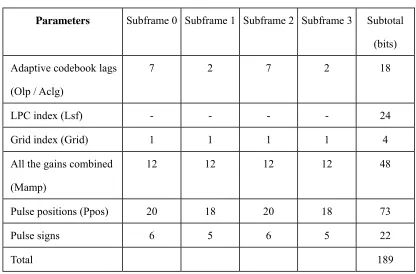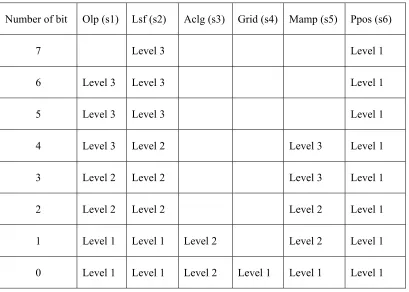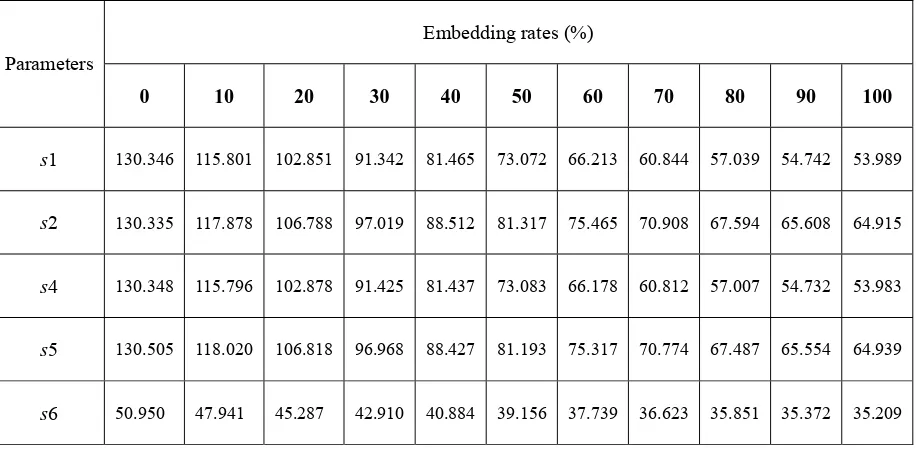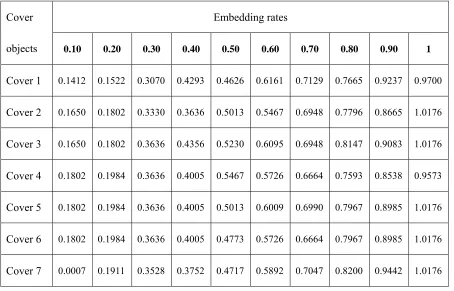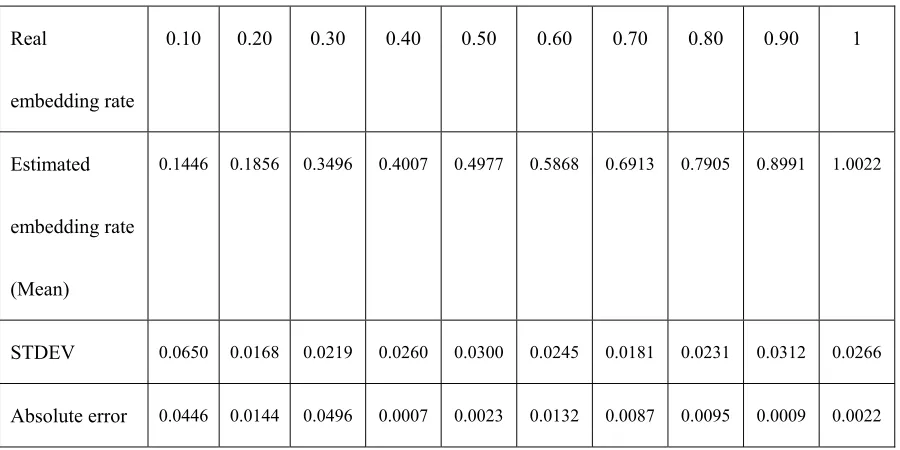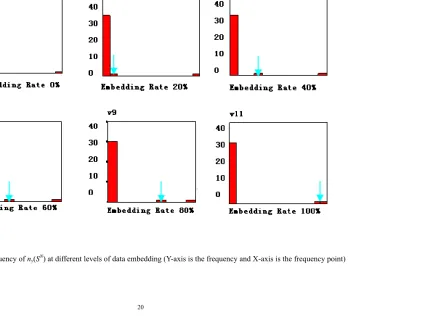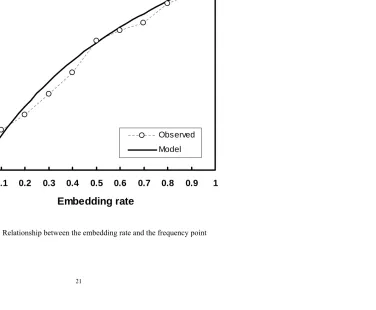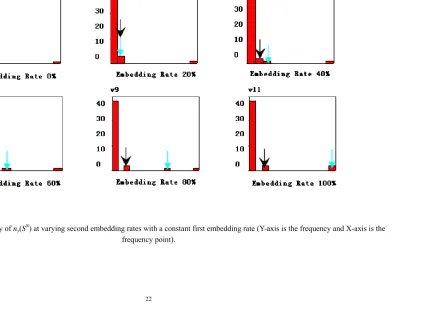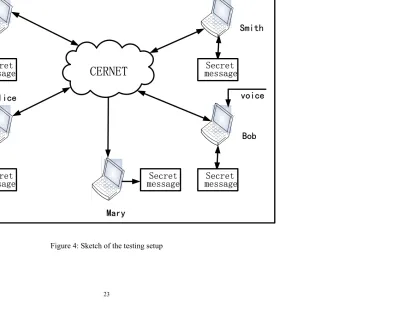Steganalysis of compressed speech to
detect covert voice over Internet protocol
channels
Huang, Y., Tang, S., Bao, C. and Yip, YJ
http://dx.doi.org/10.1049/ietifs.2010.0032
Title
Steganalysis of compressed speech to detect covert voice over Internet
protocol channels
Authors
Huang, Y., Tang, S., Bao, C. and Yip, YJ
Type
Article
URL
This version is available at: http://usir.salford.ac.uk/23103/
Published Date
2011
USIR is a digital collection of the research output of the University of Salford. Where copyright
permits, full text material held in the repository is made freely available online and can be read,
downloaded and copied for noncommercial private study or research purposes. Please check the
manuscript for any further copyright restrictions.
Steganalysis of Compressed Speech to Detect Covert VoIP Channels
Yongfeng Huang 1, Shanyu Tang 2,Chunlan Bao 1, Yau Jim Yip 3
1 Department of Electronic Engineering, Tsinghua University, Beijing 100084
2 London Metropolitan University, London N7 8DB, UK
3 University of Huddersfield, Huddersfield HD1 3DH, UK
Abstract
A network covert channel is a passage along which information leaks across the network in violation
of security policy in a completely undetectable manner. This paper reveals our findings in analysing
the principle of G.723.1 codec that there are ‘unused’ bits in G.723.1 encoded audio frames, which can
be used to embed secret messages. A novel steganalysis method that employs the second detection and
regression analysis is suggested in this study. The proposed method can detect the hidden message
embedded in a compressed VoIP speech, but also accurately estimate the embedded message length.
The method is based on the second statistics, i.e. doing a second steganography (embedding
information in a sampled speech at an embedding rate followed by embedding another information at
a different level of data embedding) in order to estimate the hidden message length. Experimental
results have proven the effectiveness of the steganalysis method for detecting the covert channel in the
compressed VoIP speech.
1. Introduction
Steganography is the art and science of hiding the very presence of covert communication by
embedding secret messages in innocent-looking electronic signals such as digital images, video and
audio. To achieve covert communication, stego-signals, which are signals containing secret messages,
should be indistinguishable from cover signals not containing any secret message. On the contrary,
steganalysis deals with the technique used to distinguish between stego-signals and cover signals [1].
Steganalysis is the science of detecting messages hidden using steganography. The goal of
steganalysis is to distinguish stego objects (containing a secret message) from cover objects with little
or no knowledge of steganographic algorithms. The simplest method to detect
steganographically-encoded packages/files is to compare them to known originals. Comparing the
package against the original file will yield the differences caused by encoding the payload – and, thus,
the payload can be extracted. Nowadays, steganalysis becomes increasingly important in computer
forensics, for tracking and screening documents/audios/videos that are suspect of criminal and
terrorism activities, and for information security to prevent leakage of unauthorized data.
There has been quite some effort to study the steganalysis of digital images, and recent
publications are [2][3][4][5][6]. In contrast to image steganography and steganalysis,audio
steganography and steganalysis are largely unexplored. Westfeld and Pfitzmann proposed a
steganalysis method for Least Significant Bit (LSB) based embedding and also addressed the
steganalysis of the MP3 steganography algorithm [7].
Voice over IP (VoIP) enables the digitalisation, compression and transmission of analogue audio
between the communicating parties have little relevance to transmission, VoIP is used for worldwide
telephony such as Skype. VoIP streams are dynamic chunks of a series of packets that consist of IP
headers, UDP headers, RTP headers, and numbers of audio frames. Those headers and frames have a
number of unused fields, providing plausible covert channels and thus giving scope for
steganography.
With the upsurge of Voice over IP applications available for commercial use in recent years, VoIP
becomes one of the most interesting cover media for information hiding. Several steganography
methods have been suggested in the literature [8][9][10][11][12][13], and some of which are based on
streaming media and their network protocols such as VoIP or IP, which are used to form network
covert channels. The network covert channel is a passage along which information leaks across the
network in violation of security policy in a completely undetectable manner.
Although some research work had managed to detect network protocols based covert channels
[14][15][16][17][18][19], so far there are still few steganalysis methods available for the compressed
VoIP speech. This is the reason that led us to propose this work in the first place. In this paper how
steganalysis can be performed in VoIP applications and operational aspects are discussed. Furthermore,
the paper focuses on introducing a novel steganalysis method for the low bit rate speech codec such as
G.723.1 widely used in VoIP communications.
Given the wealth of statistic and information-theoretic tools, several approaches may be used to
analyse problems like VoIP covert communications. One could study the capacity of the covert
channel, and then analyse the probability of detection as a function of the embedding rate, which is
defined as the ratio of the secret message length to the stego VoIP stream length. The other can
embedding. Our approach to the problem is to utilise a statistical test in combination with doing a
second steganography (i.e. embedding information in a sampled speech at an embedding rate followed
by embedding another information at a different level of data embedding) so as to estimate the
embedded message length.
The rest of this paper is organized as follows. In Section 2 the principle of the speech codec used
in VoIP, such as G.723.1, is analysed. Section 3 details a new steganalysis method for compressed
VoIP speech streams. The evaluation of the proposed steganalysis method is presented in Section 4.
Finally, it ends with conclusions in Section 5.
2. VoIP Applications with Covert Channels
In general, the ITU-G.723.1 speech codec is widely used in VoIP communications for compressing
the speech or audio signal component of streaming media. Close analysis of the principle of the
G.723.1 codec shows the G.723.1 encoded frame (a short chunk of the speech signal) is composed of a
number of speech parameters since the codec is based on Analysis-by-Synthesis (AbS) coding, one of
the vocal code models. Differing from the G.711 codec, the G.723.1 codec has two bit rates associated
with it, 5.3 kbps and 6.3 kbps. This study focuses on the high bit rate (i.e. 6.3 kb/s) because it gives
better voice quality. The 6.3 kbps codec adopts Multi-pulse Maximum Likelihood Quantization
(MP-MLQ) excitation, which is different from Algebraic Code Excited Linear Prediction (ACELP)
used by the 5.3 kbps codec.
The G.723.1 encoder is performed on a frame-by-frame basis, and it operates on frames of 240
high pass filter to remove the DC component and is then divided into four subframes of 60 samples
each. A 10th order Linear Predictive Coding (LPC) filter is computed using the unprocessed input
signal for every subframe, and the last subframe is quantized using a Predictive Split Vector Quantizer
(PSVQ). For every two subframes (120 samples), the weighted speech signal is used to compute the
open loop pitch period. A harmonic noise shaping filter is then constructed using the open loop pitch
period computed previously, and a closed loop pitch predictor is constructed according to the impulse
response created by the noise shaping filter. Finally, both the pitch period and the differential value are
transmitted to the decoder and the non-periodic component of the excitation is approximated. After
completion of these operations, all speech parameters such as LPC, Pulse sign and Pulse position and
etc., are obtained. The bit allocation of the 6.3kb/s coding algorithm is listed in Table 1. There are no
[image:6.595.88.504.470.744.2]LPC parameters for subframes and each speech frame has a LPC value of 24 bits.
Table 1: The bit allocation of the 6.3kb/s coding algorithm
Parameters Subframe 0 Subframe 1 Subframe 2 Subframe 3 Subtotal
(bits)
Adaptive codebook lags
(Olp / Aclg)
7 2 7 2 18
LPC index (Lsf) - - - - 24
Grid index (Grid) 1 1 1 1 4
All the gains combined
(Mamp)
12 12 12 12 48
Pulse positions (Ppos) 20 18 20 18 73
Pulse signs 6 5 6 5 22
Experiments were carried out to estimate the Capability of Noise Tolerance (CNT) for each
parameter of the G.723.1 codec. First, a speech frame was compressed and encoded by G.723.1
encoder to form bit streams. The least significant bits of one parameter of the bit streams were
substituted and then decoded to output a stego-speech. Similar experiments were repeated for the
other parameters, and so the difference signal-to-noise-ratio (DSNR) between the original speech and
the stego-speech was determined for each parameter.
All the speech parameters were sorted into three levels in terms of their DSNR values, and the
results are listed in Table 2. The CNT of the parameter is defined as ‘Level 1’ if its DSNR is less than
1dB. A detailed analysis of the experimental results reveals that there is much difference in CNT
between different speech parameters. For example, the parameter, Ppos, has higher Capability of
[image:7.595.95.504.475.767.2]Noise Tolerance (‘level 1’) than the other parameters such as Olp with ‘level 3’ in some bits.
Table 2: Capability of Noise Tolerance (CNT) of G.723.1 speech parameters
Number of bit Olp (s1) Lsf (s2) Aclg (s3) Grid (s4) Mamp (s5) Ppos (s6)
7 Level 3 Level 1
6 Level 3 Level 3 Level 1
5 Level 3 Level 3 Level 1
4 Level 3 Level 2 Level 3 Level 1
3 Level 2 Level 2 Level 3 Level 1
2 Level 2 Level 2 Level 2 Level 1
1 Level 1 Level 1 Level 2 Level 2 Level 1
The goal of VoIP steganography is to embed a secret binary message in the compressed VoIP
speech streams that consist of a series of packets with each carrying a certain number of audio frames.
An effective LSB steganographic algorithm for VoIP communications using G.723.1 and G.729a
codecs was suggested in our previous papers [20][21]. According to the steganographic algorithm, the
Least Significant Bits (LSBs) of some parameters of the G.723.1 codec can be replaced with secret
messages. The LSBs of parameters are those bits whose CNT levels are identified as ‘level 1’ in Table
2. In other words, the cover objects used for embedding secret messages are the LSBs of the
parameters such as Olp, Lsf, Grid, Mamp, and Ppos, denoted by S ={s1, s2, s4, s5, s6}, where s1
denotes Olp, s2 denotes Lsf, s4 denotes Grid, s5 denotes Mamp, and s6denotes Ppos.
Steganalysis, the official countermeasure to steganography, is the science of detecting and often
decoding the hidden information within the cover medium. In contrast to the LSB based
steganographic algorithm, the steganalysis of VoIP is to determine whether secret information is
embedded in the LSBs of G.723.1 encoded VoIP speeches. Having investigated the principle of the
G723.1 codec and the CNT characteristics of their speech parameters, we suggest a novel steganalysis
method in this study, which is based on second statistical detection and regression analysis. The
proposed method does not only detect the hidden information embedded in the compressed VoIP
speech, but also estimate the embedding capacity precisely.
3. Second Statistics Based Steganalysis Algorithm
the G.723.1 codec are divided into six speech parameters according to the steganographic algorithm
introduced above. Statistical analysis of these parameters is then conducted by using Poker test.
Finally, the steganalysis method is used to determine the embedding capacity.
3.1 Poker Test for Speech Parameters
Poker test is one of the statistical tools used to study and predict random phenomena. The test
starts with a set (sequence) called the sample space, which relates to the set of all possible outcomes,
denoted by S = {x1, x2, …}. Assuming that the sequence S consists of N random variables like integers,
the whole sequence is described as SN, and the number of times the variable (integer) i occurs in the
sequence is denoted by ni(S N), 0 ≤
i≤ 2L-1, where L is an integer used to define the largest variable in
the sequence.
Suppose the whole sequence SN is divided into N/L segments. If all the values of ni(S N) with
i = 0,
1, 2, …, 2L-1, i.e. the frequency of each variable occurring in the sequence, are calculated, thus, the
normalized variance of a random variable in the sequence, fTp, which is the expected square deviation
of that variable from its expected mean, can be computed by the following formula:
∑
− =⎟
⎠
⎞
⎜
⎝
⎛
×
−
⎟⎟
⎠
⎞
⎜⎜
⎝
⎛ ×
=
2 10 2 2
2
)
(
2
L i L N i L TpL
N
S
n
N
L
f
(1)where N/(L×2L)is the expected number of times the variable i occurs in the segment if each variable
has the same probability of appearing, and L×(2L)2/N is used to normalize the variance. The advantage
of using the normalized variance is that it enables comparisons between different samples.
To perform a poker test on the G.723.1 compressed speech, the whole sequence (SN) is required
to construct first. In terms of the bit allocation of the G.723.1 codec (Table 1) and the Capacity of
parameters, denoted by s1, s2, s3, s4, s5, s6, and S = {s1, s2, s3, s4, s5, s6}. Statistical analysis is then
performed on these speech parameters, respectively.
The bit sequence of the speech parameter si in the frame k is defined as
si k=
bi0, bi1,…, bi
j (2)
with i = 1, 2, …, 6, and j = 0, 1, …, sum
where sum is the total number of bits in the parameter si that can be used to embed messages. As
different parameters have different numbers of Least Significant Bit (LSB), the values of sum vary for
different parameters. Thus the whole bit sequence of the frame k is given by
Yk = s1k, s2k,…, s6k (3)
Assuming the total number of frames in a compressed speech sample is M. The bit sequence of
the parameter si for all frames, XiM, can be constructed as follows
Xi M=
si0, si1,…, si
j (4)
with i = 1, 2, …, 6, and j = 1, 2, …, M
where si
j denotes the bit
j of the parameter si. The subscript i of si
j stands for the sequence number of
the parameter, and the superscript j denotes the bit sequence number in the parameter. So the whole
bit sequence of M frames can then be described as
XM = X1M, X2M, X3M, X4M, X5M, X6M (5)
In accordance with the above Poker test algorithm, a series of experiments were conducted to
examine all the speech parameters of the G.723.1 codec, such as s1, s2, s4, s5, and s6, except for s3
because its CNT level is too high to be used for embedding messages. For example, in order to
calculate fTp of the parameter s6, the bit sequence S6N is constructed using Equation (4), where N =
the threshold value determined by observing a number of experiments, and 8 is the number of bits in
the parameter s6 that can be used to embed messages. Hence L = 8 and N/L = 152790 are obtained; M
= N/L represents the number of the tested frames.
In the experiments random messages were embedded in different speech parameters of the
G723.1 codec, leading to a number of stego-speech streams (data sets) with embedding rates varying
from 0% to 100% in 10 percent increments. A chaos random sequence generator was used to create
the embedding positions so as to achieve random embedding. The fTpvalues for different speech
parameters were calculated, and the results are listed in Table 3.
Table 3: fTpvalues for different speech parameters before and after embedding messages
Embedding rates (%) Parameters
0 10 20 30 40 50 60 70 80 90 100
s1 130.346 115.801 102.851 91.342 81.465 73.072 66.213 60.844 57.039 54.742 53.989
s2 130.335 117.878 106.788 97.019 88.512 81.317 75.465 70.908 67.594 65.608 64.915
s4 130.348 115.796 102.878 91.425 81.437 73.083 66.178 60.812 57.007 54.732 53.983
s5 130.505 118.020 106.818 96.968 88.427 81.193 75.317 70.774 67.487 65.554 64.939
s6 50.950 47.941 45.287 42.910 40.884 39.156 37.739 36.623 35.851 35.372 35.209
Analysis of the data in Table 3 shows the value of fTp decreases as the embedding rate increases
for each speech parameter. This is probably due to the reason that the randomness of stego-speech
streams becomes more significant when the embedding rate increases. The fTpvalues for different
[image:11.595.71.531.384.610.2]is required by the second statistical method (detailed in the next section) to estimate the embedding
capacity.
3.2 Second Statistical Detection and Regression Analysis
For the parameter set of the G723.1 codec, S = {s1, s2, …, s6}, the value of ni(S
N) for each
speech parameter can be computed by using the Poker test algorithm described in the preceding
section, respectively. Thus the following equation yields
yi={n0(si N
), n1(si N
), … nj(si
N)} (6)
with i∈{1, 2, 4, 5, 6}
Let Y = {y1, y2, y4, y5, y6}, a new bit sequence Y is constructed, and a new frequency value ny(s N)
can then be obtained for the sequence Y. A detailed analysis by drawing curves using SPSS (statistics
software) reveals great statistical regularity, as shown in Figure 1. Note that the calculations are based
on the parameter s6, i.e. Pulse positions (Ppos).
The arrows in Figure 1 denote the frequency points at different levels of data embedding. Figure
1 shows the frequency point increases non-linearly as the embedding rate increases. A number of
repeated experiments were conducted so as to allow the establishment of the statistical relationship
between the frequency point and the embedding rate. Regression analysis was chosen to seek for the
statistical law, i.e. a mathematical function between the frequency point and the embedding rate, as
shown in Equation (7)
3 3 2 2 1
0
a
m
a
m
a
m
a
p
=
+
+
+
(7)coefficients.
Fitting Equation (7) with plenty of similar data sets, obtained from the G.723.1 compressed
stego-speech samples having 152790 frames, leads to attaining the regression coefficients on Equation
(7) such as a0, a1, a2 and a3. So Equation (7) is re-written as
3 2
0
.
588058
511366
.
1
940232
.
1
000668
.
0
m
m
m
p
=
+
−
+
(8)The estimation curve (Model) in Figure 2 is drawn according to Equation (8), and the
experimental curve (Observed) is based on experimental results. Comparisons between the estimated
and experimental results indicate that Equation (8) accurately simulated the relationship between the
embedding rate and the frequency point. Hence, with Equation (8) ones can easily compute the
corresponding embedding rates for different frequency points.
However, there is an unsolved issue, i.e. how to decide whether a sampled speech contains
hidden messages. If a secret message is embedded in the sampled speech, the embedding rate cannot
be assumed to be 0% when computing the first frequency point in Figure 1. In fact, the correct
relationship between the frequency point and the embedding rate cannot be derived when blind
detection is performed. If so, how to compute the embedding rate in case of blind detection? To solve
this problem, a novel method based on the second steganography is suggested to estimate the
embedding rate as follows.
The second steganography with random embedding positions in the same sampled speech as the
first steganography does is suggested to decide whether the sampled speech contains hidden messages,
and determine how much information has been embedded. Suppose the first embedding rate is p1, and
message in the sampled speech at p1 followed by embedding another message at p2), p1×p2 percent of
Least Significant Bits (LSBs) in the speech parameters like s6 are changed twice, and half of the bits
in the parameters are converted to the original values again. Hence, the embedding rate equals the
percent of bits that have been changed only once after the second steganography, given by
Embedding rate = (p1 + p2 - p1×p2) / 2 (9)
In the experiments, the first embedding rates were fixed at p1 = 30%, and the second embedding
rates were varied, i.e. p2 = 10% × i with i = 0, 1, …, 10. Initially the sampled VoIP speech embedded a
message at the first embedding rate of 30%, and then embedded another message at the second
embedding rates varying from 0% to 100% in 10 percent increments, respectively. Figure 3 shows the
experimental results, depicting the relationship between the frequency of ny(s
N) and the second
embedding rate (p2) while the first embedding rate (p1) remained constant. The black coattail arrows
in the figure are related to the first embedding rates, and the common arrows are in relation to the
second embedding rates.
Close analysis of the experimental results (Figure 3) shows that the first embedding rate (black
coattail arrows) stands out well against the second embedding rate (common arrows) in the first figure
(the second embedding rate is 0%) and in the sixth figure where the second embedding rate is 100%.
For the same sampled speech, the results for the two data embedding process at p1 = 30% and p2 =
0% should be the same as those for the single data embedding process at p1 = 30%. So the frequency
point is related to the first embedding rate only when the second embedding rate is 0%. Therefore, as
long as the frequency points in Figure 3 are obtained, the embedding rate for the first steganography
4. Performance Evaluation
A series of experiments were performed to evaluate the proposed steganalysis method. Seven
groups of the compressed speech sampled from the G.723.1 codec with 6.3kp/s LOC (Lines of
Communication) were employed as cover objects. Random messages with different lengths were
embedded in each of the compressed speech cover objects, respectively, to achieve ten different
embedding rates. A chaos sequence generator was used to create random embedding positions in the
compressed speech streams so as to ensure the messages were randomly spread out over the
embedding positions. To simplify the experiments, 128 bits keys were used for steganography.
Figure 4 illustrates the testing process in which stegnography and steganalysis in VoIP streams
were carried out over an intranet called CERNET. Alice and Bob communicated secretly, so the VoIP
streams between them contain secret messages, which were embedded in the parameters of ITU-T
G.723.1 (6.3Kbps) compressed speech streams. Similarly covert communications also occurred
between John and Smith. Using our proposed steganalysis method, Mary as a warden monitored the
router connected with the network by examining all transmitted streams between Alice, Bob, John and
Smith so as to decide whether a transmission contains a hidden message and to estimate the
embedding rate.
The embedding rate is defined as the secret message length divided by the length of the stego
VoIP stream. The real embedding rates varied from 0% to 100% in 10 percent increments, which are
The proposed steganalysis method was utilised to compute the estimated embedding rates, and the
[image:16.595.75.529.196.487.2]results are listed in Table 4.
Table 4: The real and estimated embedding rates for different compressed speech cover objects
Embedding rates Cover
objects 0.10 0.20 0.30 0.40 0.50 0.60 0.70 0.80 0.90 1
Cover 1 0.1412 0.1522 0.3070 0.4293 0.4626 0.6161 0.7129 0.7665 0.9237 0.9700
Cover 2 0.1650 0.1802 0.3330 0.3636 0.5013 0.5467 0.6948 0.7796 0.8665 1.0176
Cover 3 0.1650 0.1802 0.3636 0.4356 0.5230 0.6095 0.6948 0.8147 0.9083 1.0176
Cover 4 0.1802 0.1984 0.3636 0.4005 0.5467 0.5726 0.6664 0.7593 0.8538 0.9573
Cover 5 0.1802 0.1984 0.3636 0.4005 0.5013 0.6009 0.6990 0.7967 0.8985 1.0176
Cover 6 0.1802 0.1984 0.3636 0.4005 0.4773 0.5726 0.6664 0.7967 0.8985 1.0176
Cover 7 0.0007 0.1911 0.3528 0.3752 0.4717 0.5892 0.7047 0.8200 0.9442 1.0176
Statistical tools are normally used for quantifying the accuracy and precision of a measurement
or approximation process. Accuracy is the degree of closeness of a measured or calculated quantity to
its actual (true) value, indicating proximity to the true value. So the absolute error, which is the
magnitude of the difference between the real value and the approximation, is an indication of accuracy.
Precision is the degree to which further measurements or calculations show the same or similar results.
In statistics, standard deviation is a measure of the variability or dispersion of a statistical population,
a data set, or a probability distribution. A low standard deviation indicates that the data points tend to
over a large range of values. So the standard deviation of a group of repeated calculations should give
[image:17.595.76.526.194.419.2]the precision of those calculations.
Table 5: Accuracy and precision in estimating data embedding rates
Real
embedding rate
0.10 0.20 0.30 0.40 0.50 0.60 0.70 0.80 0.90 1
Estimated
embedding rate
(Mean)
0.1446 0.1856 0.3496 0.4007 0.4977 0.5868 0.6913 0.7905 0.8991 1.0022
STDEV 0.0650 0.0168 0.0219 0.0260 0.0300 0.0245 0.0181 0.0231 0.0312 0.0266
Absolute error 0.0446 0.0144 0.0496 0.0007 0.0023 0.0132 0.0087 0.0095 0.0009 0.0022
Table 5 lists the accuracy and precision of the proposed steganalysis method in estimating data
embedding rates. A small standard deviation (STDEV) indicates that the estimated embedding rates
for the seven compressed speech samples (their results are listed in Table 4) are clustered closely
around the means at different levels of data embedding. Therefore, the experimental results show the
proposed steganalysis method has great precision in determining the embedding rate in most
circumstances, and acceptable errors occur at low embedding rates.
5. Conclusions
compressed VoIP speech and estimating the embedding rate as well. The experimental results have
shown the proposed steganalysis method is quite effective and accurate. To the best of our
knowledge, this is the first practical implementation of the steganalysis of the compressed VoIP
speech.
This work is an initial exploration of the detection of covert channels in the compressed VoIP
speech and there is room for improvement. Other steganalysis methods for detecting hidden
information in other compressed speeches such as iLBC and G.729.a are the subjects of future work.
Acknowledgments
This work was supported in part by grants from the National High Technology Research and
Development Program of China (863 Program, No. 2006AA01Z444), the National Foundation
Theory Research of China (973 Program, No. 2007CB310806), and the National Natural Science
Foundation of China (No. 60703053, and No. 60773140).
References
[1] Avcibas, I.: ‘Audio steganalysis with content-independent distortion measure’, IEEE Signal
Processing Letters, 2006, 12, (2), pp. 92-113
[2] Fridrich, J., and Goljan, M.: ‘Practical steganalysis of digital images-state of the art’. Security
and Watermarking of Multimedia Contents IV, San Jose, USA, January 2002, pp. 1-13
[3] Fridrich, J., Goljan, M., and Hogea, D.: ‘Steganalysis of JPEG images: Breaking the F5
algorithm’. Proc. 5th Information Hiding Workshop, Toronto, CA, May 2002, pp. 23-35
images’, IEEE Multimedia, 2001, 8, (4), pp. 22-28
[5] Ru, X.M., Zhang, H.J., and Huang, X.: ‘Steganalysis of audio: Attacking the steghide’. Proc.
Fourth International Conference on Machine Learning and Cybernetics, Guangzhou, China, August
2005, pp. 3937-3942
[6] Zhang, T.: ‘Image steganalysis of bit randomicity’. PhD thesis, Tsinghua University, 2003
[7] Westfeld, A., and Pfitzmann, A.: ‘Attacks on steganographic systems’. Lecture Notes in
Computer Science, vol. 1768, Springer-Verlag, Berlin, 2000, pp. 61-76
[8] Westfeld, A.: ‘Detecting low embedding rates’. Proc 5th Int. Workshop Information Hiding,
Noordwijkerhout, The Netherlands, October 2002, pp. 324-339
[9] Mazurczyk, W., and Kotulski, Z.: ‘New VoIP traffic security scheme with digital
watermarking’. Proc SafeComp 2006, Lecture Notes in Computer Science 4166, Springer-Verlag,
Heidelberg, 2006, pp. 170-181
[10] Kuhn, D.R., Walsh, T.J., and Fries, S.: ‘Security considerations for Voice over IP systems’.
National Institute of Standards and Technology, U.S. Department of Commerce, 2004
[11] Kraetzer, C., Dittmann, J., Vogel, T., and Hillert, R.: ‘Design and evaluation of
steganography for Voice-over-IP’. Proceedings of 2006 IEEE International Symposium on Circuits
and Systems, Island of Kos, Greece, May 2006, pp. 2397-2340
[12] Tian, H., Zhou, K., Jiang, H., Huang, Y., Liu, J., and Feng, D.: ‘An adaptive steganography
scheme for Voice over IP’. Proc. IEEE International Symposium on Circuits and Systems, Taipei,
Taiwan, May 2009, pp. 2921-2925
[13] Mazurczyk, W., and Szczypiorski, K.: ‘Steganography of VoIP streams’, Lecture Notes in
[14] Dittmann, J., Hesse, D., and Hillert, R.: ‘Steganography and steganalysis in Voice-over IP
scenarios: operational aspects and first experience with a new steganalysis tool set’. Security,
Steganography, and Watermarking of Multimedia Contents VII, SPIE vol. 5681, Jan. 2005, pp.
607-618
[15] Wray, J.C.: ‘An analysis of covert timing channels’. Proc. IEEE Computer Society
Symposium on Research in Security and Privacy, May 1991, pp.2-7
[16] Dittmann, J., and Hesse, D.: ‘Network based intrusion detection to detect steganographic
communications channels - on the example of audio data’. Proc. 6th IEEE Workshop on Multimedia
Signal Processing, Siena, Italy, September 2004, ISBN 0-7803-8579-9.
[17] Gul, G., Dirik, A.E., and Avcibas, I.: ‘Steganalytic features for JPEG compression-based
perturbed quantization’, IEEE Signal Processing Letters, 2007, 14, (3), pp.205-208
[18] Kraetzer, C., and Dittmann, J.: ‘Mel-Cepstrum based steganalysis for VoIP-steganography’.
IS&T/SPIE Symposium on Electronic Imaging, Security, Steganography, and Watermarking of
Multimedia Contents VIII, San Jose, USA, January 2007.
[19] Liu, Q., Sung, A.H., and Qiao, M.: ‘Temporal derivative-based spectrum and mel-cepstrum
audio steganalysis’, IEEE Transactions on Information Forensics and Security, 2009, 4, (3), pp.
359-368
[20] Su, Y., and Huang, Y.: ‘Steganography-oriented noisy resistance model of G.729a’, IMACS
Multi-conference on Computational Engineering in Systems Applications, 2006, 1, pp. 11-15
[21] Xiao, B., Huang, Y., and Tang, S.: ‘An approach to information hiding in low bit-rate speech
0
0.2
0.4
0.6
0.8
1
0
0.1
0.2
0.3
0.4
0.5
0.6
0.7
0.8
0.9
1
Embedding rate
Fr
e
q
ue
nc
y
point
Observed
[image:22.595.219.620.111.455.2]Model
Figure 3: The frequency of ny(SN) at varying second embedding rates with a constant first embedding rate (Y-axis is the frequency and X-axis is the
